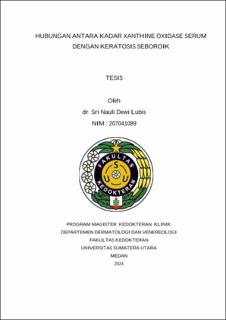| dc.contributor.advisor | Putra, Imam Budi | |
| dc.contributor.advisor | Jusuf, Nelva Karmila | |
| dc.contributor.author | Lubis, Sri Nauli Dewi | |
| dc.date.accessioned | 2025-01-16T02:51:29Z | |
| dc.date.available | 2025-01-16T02:51:29Z | |
| dc.date.issued | 2024 | |
| dc.identifier.uri | https://repositori.usu.ac.id/handle/123456789/100195 | |
| dc.description.abstract | Background: Seborrheic keratosis (KS) is a type of benign skin tumour that often
occurs in adults and elderly individuals. Although the exact cause of KS is not fully
understood, genetics, sun exposure and infection are factors that are thought to play
a role in the process. Repeated exposure to ultraviolet (UV) increases Guanine
Deaminase (GDA) levels and triggers an increase in xanthine oxidase (XO) levels
which is a pro-oxidant enzyme that contributes to the production of reactive oxygen
species (ROS), where increased ROS can cause oxidative stress. Oxidative stress
has an important role in the pathophysiology of KS by influencing skin aging,
inducing DNA damage, and triggering abnormal epidermal cell proliferation.
Objective: To determine the relationship between serum XO levels and KS.
Subjects and Methods: This study is an observational study with a cross-sectional
design of 40 KS patients and 40 subjects without KS. All study subjects underwent
anamnesis, dermatological examination, dermoscopic examination and followed by
blood sampling to assess serum XO levels using the ELISA test. The data were
analysed with the Mann-Whitney analytical test.
Results: This study shows there is a relationship between serum XO levels and KS.
Gender in the subject of KS was female as many as 36 people (90%) and male as
many as 4 people (10%). The most common age of KS is in the age group 40-50
years as many as 24 people (60%). The most common occupation affected by KS
is agriculture by 14 people (35%). The increase in the mean value of XO levels in
the KS group was 21.09 ng/mL, while in the control group there was a decrease in
XO levels with a mean of 14.49 ng/mL. The results of this study indicate that there
is a significant relationship between serum XO levels and KS (p < 0.001).
Conclusion: There is a relationship between serum XO levels and SK. | en_US |
| dc.language.iso | id | en_US |
| dc.publisher | Universitas Sumatera Utara | en_US |
| dc.subject | Seborrhoeic keratosis | en_US |
| dc.subject | xanthine oxidase | en_US |
| dc.subject | reactive oxygen species | en_US |
| dc.subject | oxidative stress | en_US |
| dc.title | Hubungan Antara Kadar Xanthine Oxidase Serum dengan Keratosis Seboroik | en_US |
| dc.title.alternative | Relationship between Serum Xanthine Oxidase Levels and Seborrheic Keratosis | en_US |
| dc.type | Thesis | en_US |
| dc.identifier.nim | NIM207041089 | |
| dc.identifier.nidn | NIDN0025076506 | |
| dc.identifier.nidn | NIDN0015096702 | |
| dc.identifier.kodeprodi | KODEPRODI11103#Ilmu Kedokteran Klinis | |
| dc.description.pages | 92 Pages | en_US |
| dc.description.type | Tesis Magister | en_US |
| dc.subject.sdgs | SDGs 3. Good Health And Well Being | en_US |


